March 13, 1916 - The 1st Anzac Corps, composed of the Australian 1st and 2nd Divisions along with the New Zealand Division begin to sail from Egypt to France under the command of General Birdwood. The 2nd Anzac Corps, composed of the Australian 4th and 5th Divisions remain in Egypt, under General Godley.
March 19, 1916 - Troopships carrying the Australian 1st and 2nd Division arrive in Marseilles in the south of France. The Australian troops are then moved by rail north to the battlefields. The Australian troops are billeted in the St Omer-Aire-Hazebrouck region of French Flanders which was known as the "Nursery".
April 1, 1916 - Australian reconnaissance parties entered the line for the first time.
April 7, 1916 - Australian 2nd Division begins to take over a sector of the front lines. By the end of the next week the Australian 1st Division is entering the line also just south of the already committed Australian 2nd Division.
Mid April, 1916 - Australian 1st and 2nd Divisions are committed in the line at Fleurbaix, just south of the manufacturing town Armentières, with a population of about 30,000 on the Lys River near the Belgium border. They replace the British II Corps and have command of the area south east of Armentières.
Armentières Grand Palace and belfry

The first Australian casualties of the Western Front occur when 2 officers and 72 men of the 9th ( Queensland ) Battalion are killed or wounded when German shells hit farmhouses they are sheltering in.
June 25, 1916 - First Australian Victoria Cross ( VC ) on the Western Front. John William Jackson led 8 officers and 73 others, all volunteers from the 5th Brigade to harass enemy positions at Bois Grenier, near Armentières.
Awards
![]() Private John William Alexander Jackson, 17th Battalion, 5th Brigade, 2nd Division - Victoria Cross
Private John William Alexander Jackson, 17th Battalion, 5th Brigade, 2nd Division - Victoria Cross
July 1, 1916 - First battle of the Somme commences. Britain loses 20,000 killed and 40,000 wounded after the offensive is proceeded by 9 days of shelling.
July 5 , 1916 - Australian 4th and 5th Divisions relieve the 1st and 2nd Divisions in the Nursery.
July 19, 1916 - Australian 1st Division enters the rear area of Albert in preparation for action at Pozières .
July 19, 1916 - Battle of Fleurbaix commences near Fromelles. The Australian 5th Division is committed in a poorly planned and executed attempt to take German trench lines.
Fromelles - 1916
Battlefield location
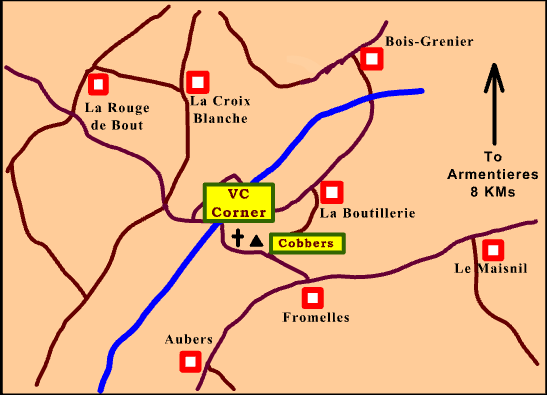
The attack on Fromelles, or the Battle of Fleurbaix, was the brainchild of the British General Sir Richard Haking. Into the battle was thrust the Australian 5th Division under the command of the Australian Major-General J. W. McKay along with the British 61st. The plan called for the capture of enemy positions that protected Fromelles. In 1915 the British had attempted two similar attacks and been twice defeated heavily. They attempted again in June 1916 much to the same result.
The Germans held the higher ground that overlooked the plain. The key German positions were those of Sugar Loaf, a salient that jutted out from the German lines.
Brigade positions prior to attack
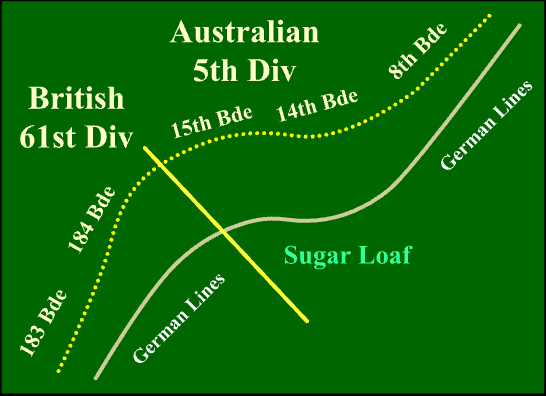
Barrage began at 11am. The Australian 5th Division attacked at 6pm supported by the British 61st Division. The Australian 15th Brigade quickly became pinned in no man's land in front of Sugar Loaf. The Australian 8th and 14th Brigades to the left of the Australian 15th captured 800 metres of the enemy front line trench. The ineffective penetration of the Australian 15th Brigade towards Sugar Loaf left the right flank of the Australian 14th Brigade exposed to the Germans who still occupied Sugar Loaf.
The British 61st Division, to the right of the Australian 15th Brigade, had also failed to make any positive gains towards Sugar Loaf now planned another attack. The British asked the already heavily strained Australian 15th Brigade to assist at 9pm as dusk fell. A brave attempt was made by half of the Australian 58th Battalion lead by Major A. J. S. Hutchinson, however the attack by the British 61st Division had been cancelled, but news of this didn't reach the Australians in time. The attack by the Australians was doomed from the start and many more men, including Major Hutchinson were killed.
Relics from Fromelles at the Australian War Memorial
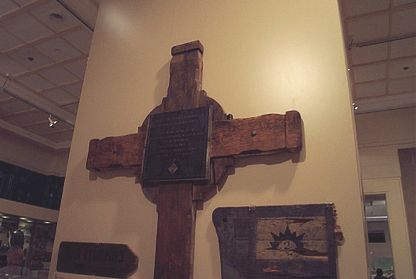
General Haking now decided to withdraw all troops to the old front line trenches and renew the attack the next day. However, German forces who had been driven from the line attempted to recapture both flanks of the Australian lines. On the right flank the old German front line trench had been left empty in accordance with orders that once the trenches were cleared the troops were to advance. The Bavarian troops from Sugar Loaf were able to occupy these empty trenches. The German troops now stood between the Australian 8th Brigade and the original Australian lines. The Australians realised the situation and counter attacked the Germans and managed to stop the enemy from infiltrating further but were unable to drive them out.
Germans infiltrate behind Australian advance
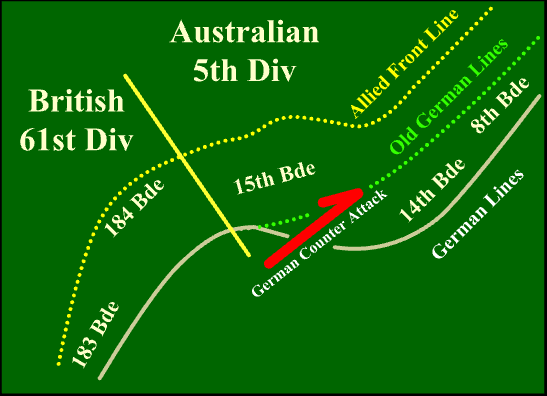
It was now night and all troops tried to improve their defenses while others tried to reinforce. The inexperience and eagerness of the Australian troops became evident when most of the parties carrying supplies forward stayed to fight with their mates, rather than return for more supplies.
At 2am the forward commander of the Australian 14th Brigade realised that this right flank was exposed to his enemy. Now the Bavarians attacked again and forced their way further behind the Australian 14th Brigade. Australian troops now found themselves being fired from both the front and rear. The Australian troops continued to hold their positions in an ever more doomed situation. By morning the only option was to charge the German troops holding the old German front lines behind the Australians in an effort to return to their lines.
By 3.45am the Australian who were left were now fighting their way back through German lines, making a charge back to their original battle starting positions. By 5.45 am on the 20th of July, the Australian 8th Brigade was forced out of the German lines. By 8am, the general order to withdraw had been given. However, many parties of troops of Australian remained cut off and unable to break out, they continued fighting until finally silenced about 9.20 am.
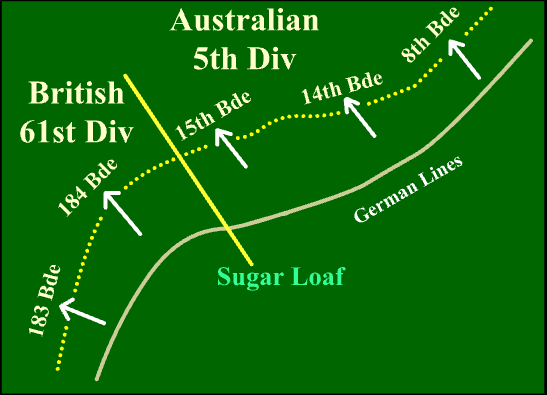
Allied forces retreat to jumping off positions
The battle at Fromelles was the only battle in which the AIF fought in the Western Front that failed to produce a positive response. Much of the blame for this was placed on poor planning and execution of the British High command, supposedly "professional" soldiers. The battle put the Australian 5th Division out of offensive actions for many months.
Cemeteries
VC Corner
The VC Corner cemetery is unique amongst cemeteries of the region because it has no gravestones and contains only Australians. On the wall at the rear are the names of 1,299 Australians who died in the battle and have no known grave.
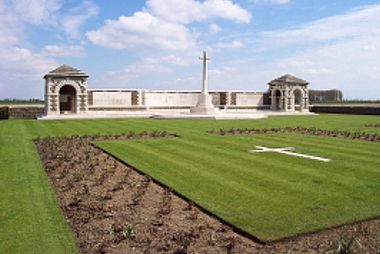
Australian VC Corner Cemetery - Fromelles
The unidentified bodies of 410 are buried in the lawns, each marked by a rose bush. The cemetery was situated in no-man's land between the Australian and German lines in 1916.
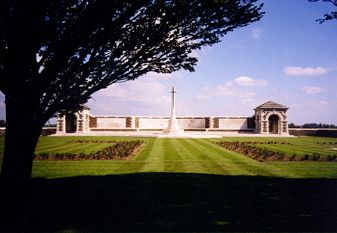
Australian VC Corner Cemetery - Fromelles
The inscription on the screen wall reads :
| "In honour of the 410 unknown Australian soldiers here buried, who were among the 1,299 Officers, Non-Commissioned Officers and Men of the Australian Imperial Force, killed in the Attack on Fromelles, July 19th and 20th, 1916." |
Memorials
Australian Memorial Park - "Cobbers"
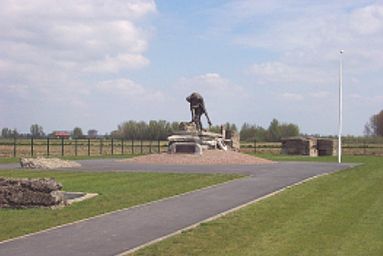
Australian Memorial Park with a German blockhouse in the background
The 'Cobbers ' Memorial by sculptor Peter Corlett depicts the work of Sergeant Simon Fraser of the 57th Battalion, one of the many who risked their lives to help rescue wounded men lying in no-man's land. Sergeant Fraser was a farmer of about 40 years before he joined the call to arms. Fraser ( by then a lieutenant ) was later killed in action at Bullecourt on 12 May 1917. He has no known grave but is remembered on the Villers-Bretonneux National Memorial.
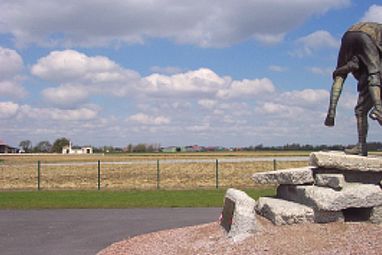
"Cobbers" with VC Corner Cemetery in distance
The memorial is a short distance from VC Corner cemetery and is situated around the remains of German fortifications on the part of the line that was captured by the 14th Brigade and held overnight 19 - 20 July 1916. The remains of some of these German fortifications can still be found on site.
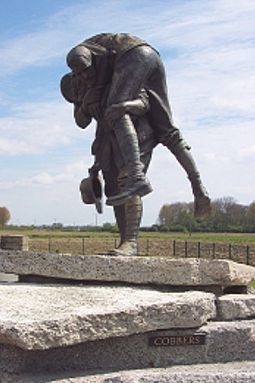
Cobbers
The statue was unveiled by Peter Corlett on 5 July 1998. The memorial is unique among many of the memorials that are scattered around the landscape in that it reflects the human rather than military face of the war. A nearby plaque reads :
" In this brief action the British suffered 1,547 casualties, the Australians a devastating 5,333. It was the only time in France that the Australians failed to take their military objective."
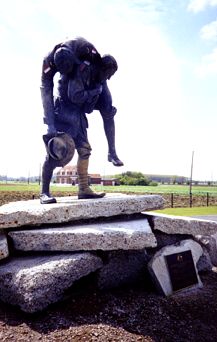
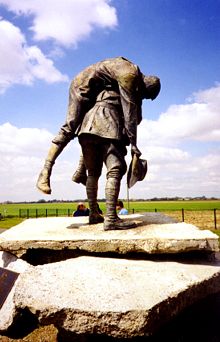
July 20, 1916 - Battle of Fleurbaix ceases. The Australian 5th Division loses 5,333 officers and men, and 400 prisoners, in a 27 hour period. Heavy losses are evidenced by the 60th Battalion ( Victoria ) which commenced the battle with 887 men and when finished had only 1 officer and 106 men.
Losses :
Australian = 5,533 killed or wounded, 400 prisoners
British = 1,547 killed or wounded
Germans = 1,500 killed or wounded
July 23, 1916 - Australian 1st Division commences action at Pozières.
Pozières - 1916
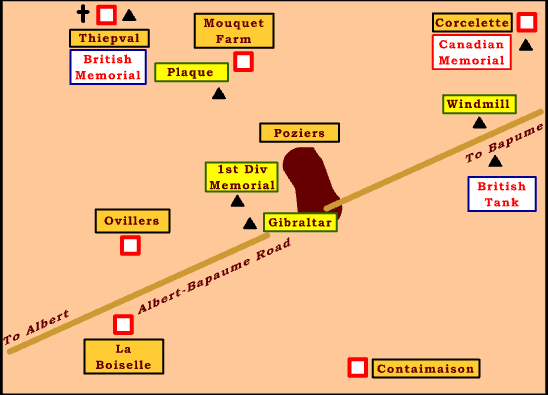
Battlefield location
The capture of the heights of Thiepval to the north of the town Pozières needed to be made from German hands. From July 13 - 15, 1916 the British had made 4 attacks at Pozières, the final attack, after artillery had reduced the village to rubble made no gain and cost the British 12,000 men.
Just south of Pozières the British attack had pressed just enough forward to create a salient in the German lines. This meant that a fresh attack could be made from both the west and south. The Australian 1st Division was to make the attack from the south on July 23, 1916. The initial object was to capture the German trenches between the Albert Road and OG1 ( Old German Lines 1 ) and then capture the village. The Australians would have the British 48th Division in support on their left.
At 12.28 am on July 23, 1916 the Australian 1st and 3rd Brigades of 1st Division attacked and seized the front German positions after bombardment from the field artillery. Thirty minutes later they attacked again after bombardment from the field artillery. This second stage brought the troops to hedges just outside Pozières. They continued their third phase of the attack to the road through the village as the Germans fell back. The Germans counter attacked at dawn but were shot to pieces. The Australian had now taken all the objectives they were set except for the old German lines ( OG1 ). As artillery had turned the area into a virtual moonscape locating objectives and determining exact positions became extremely difficult. The Germans had also decreed that any ground lost was to be retaken at once, at any cost.
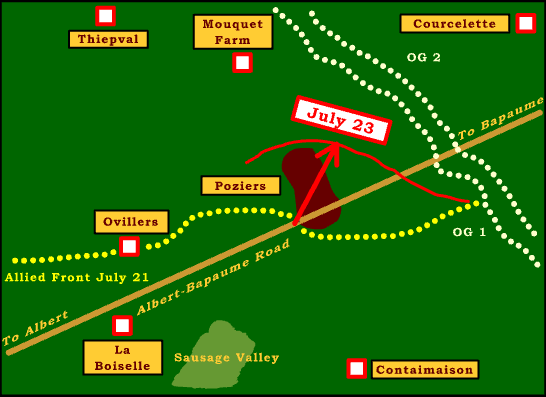
Initial attack by Australian 1st Division on Pozières
During July 23rd most of the Australian forward troops deepened their trenches in preparation for a German counter attack. Captain E.E. Herrod and Lieutenant W.L. Waterhouse of the 2nd Battalion, with 15 men captured the German strong point known to the British as "Gibraltar" which was considered by the British as impregnable.
With the leading strong position neutralized the task of moving through the village was given to the 8th Battalion of the 2nd Brigade on 24 July,1916. After 3 days of battle, on the 27th of July, the 1st Division lost 5,285 officers and men and was replaced by the Australian 2nd Division, commanded by Major General Legge. The Pozières area was the only place in which any ground had been gained on a 2.5 kilometre front of General Haig's attack on the German IV Corps.
Pozières diorama at the Australian War Memorial
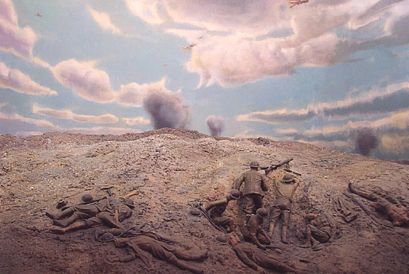
The OG lines could now been seen from the eastern edge of Pozières, with the first belt of wire 800 metres to the north and east of the forward Australian positions. On August 4, 1916 OG1 was rushed at 9.15am. At 9.30am OG2 was rushed. A small party of the 27th and 28th Battalion, led by Captain Maitland Foss captured the "Windmill Site" on 5 August 1916. The Germans counter attacked with artillery on the night of August 6, 1916 preventing the Australian 2nd Division being relieved by the Australian 4th Division. At 4am the Germans recaptured OG2 and several dugouts in OG1, however after some inspired bravery from Lieutenant Jacka, the Australians successfully counter attacked. The Germans were repulsed.
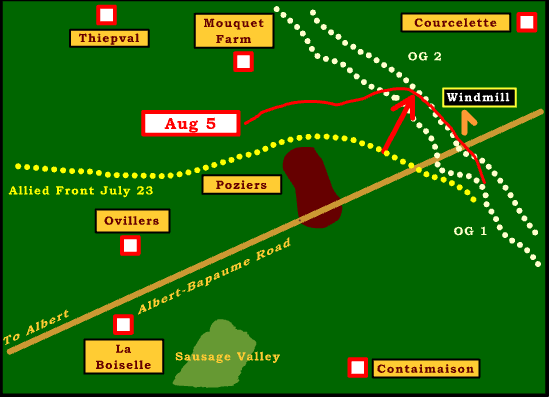
Attack by Australian 2nd Division
The Australian 2nd Division after 10 days of fighting, on August 6th, 1916, had lost 6,848 officers and men and was replaced by the Australian 4th Division, commanded by British Major General H.V. Cox. The severity of these losses is reflected by units such as the 28th Battalion of the 8th Brigade which were reduced to 130 men from 800 and the 27th Battalion which was left with 100 survivors.
Even in face or such slaughter British General Gough still wanted to capture Thiepval. The Australian 4th Division was ordered to proceed north along the Pozières ridge and capture Mouquet Farm rather than continue west through the German OG lines. The Division entered the battle on 6 August 1917.
On the night of August 10, 1916 Australian patrols pushed out and established posts in the valley south of Mouquet Farm. Captain Harry Murray of the 13th Battalion captured 200 metres of Fabeck Graben Trench on 7 - 8 August, 1916, deep in enemy lines. Murray had to eventually withdraw after heavy counter-attacks. The 16th Battalion also captured Point 78 but was unable to capture Mouquet Farm.
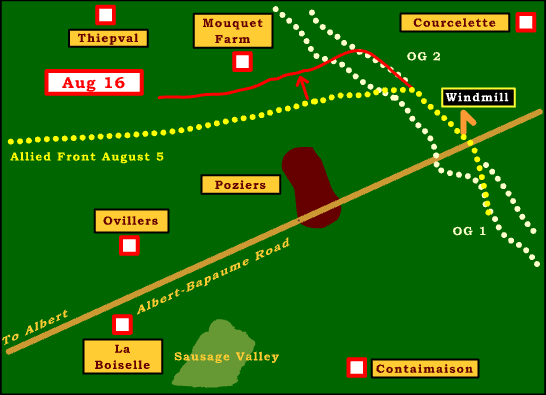
Attacks by the Australian 4th Division
After fierce fighting with little gain, on August 21, 1916 the Australian 4th Division was replaced after sustaining 4,649 casualties, with the Australian 1st Division to continue the attack on Mouquet Farm. The Australian 1st Division returned to the front line a full one-third under strength after the losses it had sustained a few days earlier.
The Australian 1st Division made some ground but lost 92 officers and 2,558 men and as such was now virtually destroyed. The Australian 2nd Division was now returned to the battle to replace the remnants of the Australian 1st Division, however it faired little better. In 4 days the Australian 2nd Division lost 1,268 men and had to be replaced by the Australian 4th Division which continued the attacks on Mouquet Farm on August 27 and 29 1916 but failed to take the position from the German defenders.
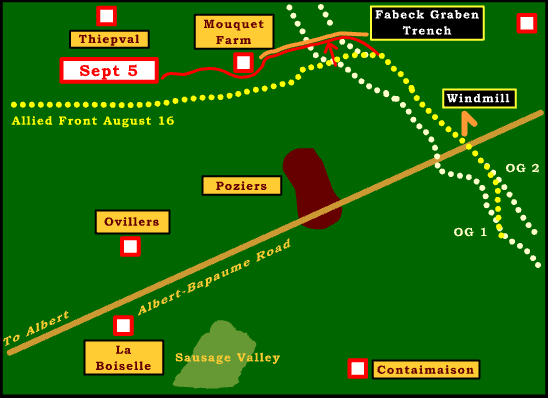
Final Australian Attacks
The last Australian attack on Pozières was on 3 September, 1916. The Australian 1st, 2nd and 4th Divisions had been used by their commanders as a battering ram and lost nearly 23,000 officers and men in a mere 6 weeks on a front that extended little more than a mile. This casualty figure represented 50% of the total of all 3 divisions strength.
Awards
![]() Lieutenant Arthur Seaforth Blackburn, 10th Battalion, 3rd Brigade, 1st Division - Victoria Cross
Lieutenant Arthur Seaforth Blackburn, 10th Battalion, 3rd Brigade, 1st Division - Victoria Cross
![]() Private Thomas Cooke, 8th Battalion, 2nd Brigade, 1st Division - Victoria Cross
Private Thomas Cooke, 8th Battalion, 2nd Brigade, 1st Division - Victoria Cross
![]() Private John Leak, 9th Battalion, 3rd Brigade, 1st Division - Victoria Cross
Private John Leak, 9th Battalion, 3rd Brigade, 1st Division - Victoria Cross
![]() Sergeant Claud Charles Castleton, 5th Machine Gun Company, 5th Brigade, 2nd Division - Victoria Cross
Sergeant Claud Charles Castleton, 5th Machine Gun Company, 5th Brigade, 2nd Division - Victoria Cross
![]() Private Martin O'Meara, 16th Battalion, 4th Brigade, 4th Division - Victoria Cross
Private Martin O'Meara, 16th Battalion, 4th Brigade, 4th Division - Victoria Cross
Memorials
Windmill Site
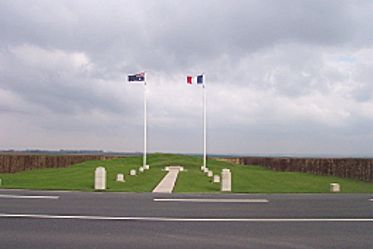
Windmill site from Albert-Bapaume road
This Windmill memorial lies on the side of the Albert-Bapaume Road on the eastern side of Pozières. Between the Australian and French flags visitors will find the following stone plaque.
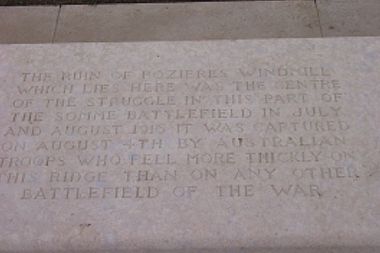
It reads :
| THE RUIN OF POZIERES WINDMILL WHICH LIES HERE WAS THE CENTRE OF THE STRUGGLE IN THIS PART OF THE SOMME BATTLEFIELD IN JULY AND AUGUST 1916. IT WAS CAPTURED ON AUGUST 4TH BY AUSTRALIAN TROOPS WHO FELL MORE THICKLY ON THIS RIDGE THAN ON ANY OTHER BATTLEFIELD OF THE WAR |
Location were the old Windmill stood
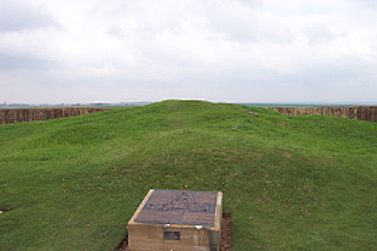
Proceeding further into the memorial you will find the mound that the Windmill stood on.
Fields of Pozières today
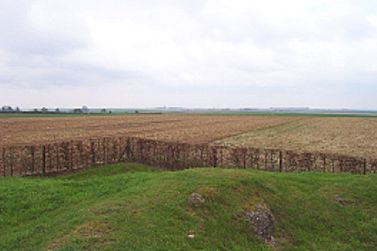
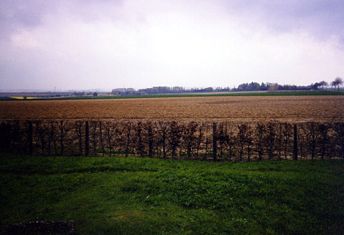
Standing on the mound where the Windmill stood gives one a good idea of area around which the battle Pozières took place.
British Tank Memorial
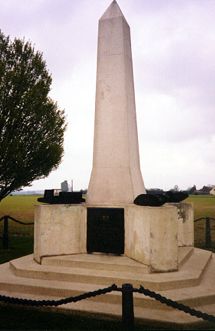
This memorial is located just across the Albert-Bapaume road from the Australian Windmill site.
Australian 1st Division Memorial
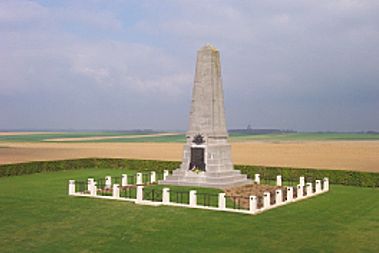
The obelisk monument to the Australian 1st Division is about 100 metres off the Albert-Bapaume road, on the Albert side of Pozières ( eastern side of the village ). Its location here is in remembrance of the bitter fighting that cost the Division more than any other action. During the battle an important enemy trench ran just in front of the memorial.
Australian 1st Division Memorial
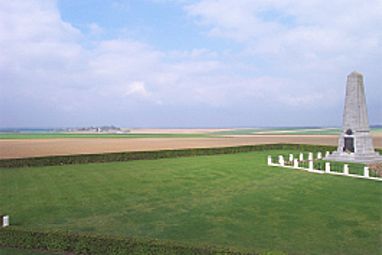
Gibraltar
This German blockhouse constructed of re-inforced concrete was the strongest single enemy position in Pozières. It lies just across from the Australian 1st Divisional memorial. There is not much these days to denote it as a feared enemy position but upon closer inspection you get a good idea of just what a formidable position it must have been. It was captured by soldiers of the Australian 1st Division's 2nd Battalion on 23 July, 1916.
Mouquet Farm
Current farm house in the distance
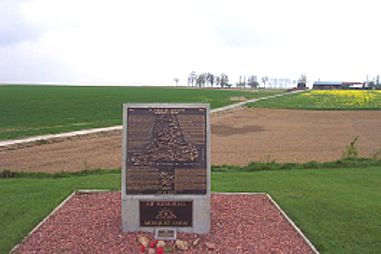
Located to the west of Pozières was the German fortress of Mouquet Farm. The current farmhouse is about 200 metres closer to the Albert-Bapaume road than the original one.
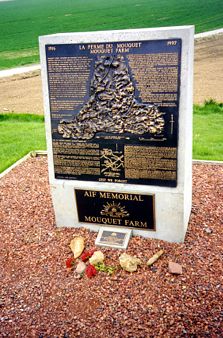
3 September, 1916 - Last attack by Australians on Pozières. Total losses for the 6 week period :
1st Division = 7,000
2nd Division = 8,100
4th Division = 7,100
5 September, 1916 - Canadian troops relieve Australian troops at Pozières. Australian now withdrawn from the Somme and sent north to the Ypres salient in Flanders.
8 September, 1916 - Canadians lost Fabeck Trench, earlier captured by the Australians near Mouquet Farrm, after a German counter attack.
26 September, 1916 - Mouquet Farm finally captured.
November, 1916 - Australian 3rd Division commanded by General Monash arrives in France.
November 5, 1916 - 2 attacks made by Australians at Gueudecourt and Flers.
November 14, 1916 - Australians attack Flers.

